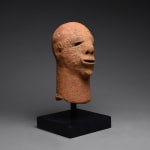Nok Terracotta Head, 300 BCE - 200 CE
Terracotta
height 20.3 cm
height 8 in
height 8 in
DC.346
Further images
The Nok civilization appeared in Nigeria around 500 B.C. and mysteriously vanished around 200 AD. The civilization’s social system was extremely advanced representing the end of the Neolithic age (Stone...
The Nok civilization appeared in Nigeria around 500 B.C. and mysteriously vanished around 200 AD. The civilization’s social system was extremely advanced representing the end of the Neolithic age (Stone Age) and start of the Iron Age in Africa. The Nok civilization was considered to be the earliest sub-Saharan producer of life-sized Terracotta. Nok culture terracottas are heralded as the prime evidence of the refinement of African civilizations, and it is suggested that the society eventually evolved into the later Yoruba kingdom of Ife. The refinement of this civilisation is attested to by the image of a Nok dignitary at the Metropolitan Museum in New York. The dignitary is portrayed wearing a "shepherds crook" affixed with an elastic material to the right arm.[1] The dignitary is also portrayed sitting with flared nostrils, and an open mouth suggesting the deep inspiration and exhalation associated with meditation. An elaborate hair style adorned with Jewelry is indicative of a stable, prosperous long-standing civilisation. According to some accounts, based on artistic similarities between early Yoruba art forms and Nok forms, there may be connections between Nok culture and contemporary Yoruba peoples. Later brass and terracotta sculptures of the Ife and Benin cultures show significant similarities with those found at Nok.







